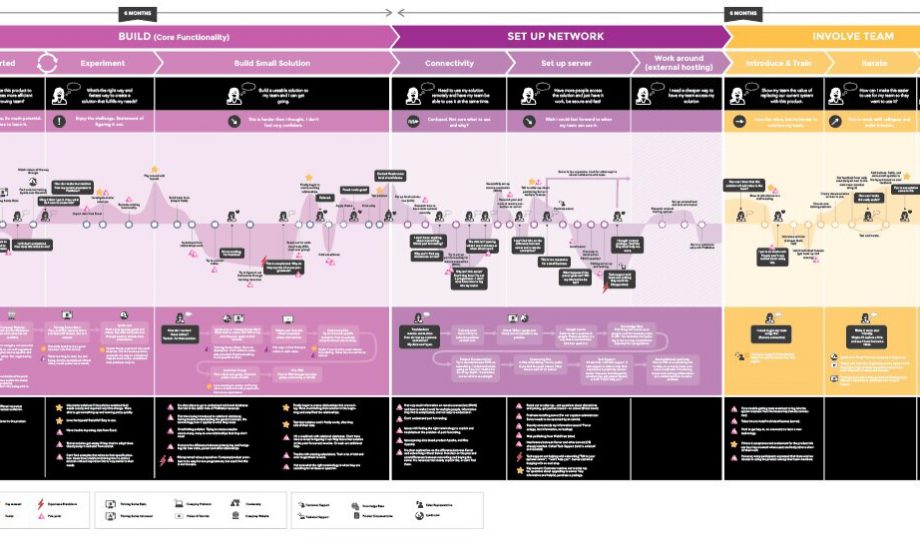Author: Kristin Swan
Welcome to part two of our series on great design teams!
If you haven’t yet, make sure to check out Part One of this series: The Secret Sauce Behind Great UX and Service Design Teams. It features Outwitly’s design team members sharing their thoughts on the key ingredients to success. From navigating the complexities of a remote working environment and making the right moves when joining a new team to the importance of clarity, support, and communication, they cover it all – Part One is a must-read!
As promised, we’re back with Part Two! Today’s post comes from Outwitly’s wonderfully talented Director of Strategic Design, Kristin Swan. Similarly to the first installment of this blog series, Kristin will cover…
- The unique (and majorly impressive!) career journey that’s brought her to her current role with us here at Outwitly.
- Clarity, communication, and collaboration: The three C’s of design team excellence.
- Five cultural components of thriving UX and service design teams.
Let’s dive in!
Meet Kristin Swan, Director of Strategic Design
Time in your career: 15+ years.
Different roles you’ve held:
I have had a couple of careers in my life so far. The first was wearing every hat imaginable in my father’s small manufacturing business. I worked there for years on school breaks and in summer doing: office management, marketing, procurement, running machines, establishing OSHA standards, and even overseeing forklift driving certifications to employees!
I left university and focused on large-scale software project management at Microsoft. I started there as an intern and rose through the ranks over eight years to Business Manager, Team Lead, Sr Program Manager, and eventually PMO Lead (program management office lead) for the launch of Office 2010.
After a move around the world and heading back to university for a Master’s degree, I began my subsequent career in Service Design. I have worked as a Service Designer in the Finnish government and the non-profit sector. I joined the Intact Innovation Lab in Montreal in 2019 as a Senior Service Designer and eventually became Manager of Strategic Design. I had the great pleasure of joining Outwitly as the Director of Strategic Design 6 months ago!
Education:
- Master’s in Business Strategy at Aalto University
- Minor in Urban Studies and Planning at the University of Helsinki
- Stanford’s Global Design Innovation capstone at Aalto University
- Design for Government – advanced studio at Aalto University
- Bachelor in Business & Economics, Major: Manufacturing and Supply Chain Management at Western Washington University
What makes an effective design team?
From my experience, there are a few basic ingredients to great teams in general, and amazing design teams need all of that, plus a little bit more. The most effective teams, in general, require a mix of a clear shared vision, communication, and a splash of fun. Stellar design teams need all of that plus an extra emphasis on time and space to collaborate, psychological safety to be creative and imaginative, plus a practice of reflection.
Let’s dig deeper into the many things that make up great UX and service design teams.
Clarity, Communication, and Collaboration: The Three C’s of Design Team Excellence
First and foremost, let’s discuss the importance of clarity, communication, and collaboration. Getting clear on the where and why, or “vision,” being a strong communicator, and working collaboratively are all essential to an effective design team!
- Find clarity by setting a “north star.” First and foremost, teams need to know where they are headed and why. A vision or purpose must be clearly, broadly shared, and commonly understood. The best example of why this is so important is to look at it when it is not present. Have you ever been on a team where the vision wasn’t clear? Or perhaps the organization’s actions didn’t seem to match the stated purpose? There is nothing that will break down a team faster. As human beings, we have this inherent craving to know where we are going and why. A clear and shared vision acts as a “north star” to guide the team, showing when it is headed in the right direction or running a bit off track, and even helps the team understand how success will be measured.
- Promote open, honest and direct communication. None of that is possible without clear, open, honest and direct communication. Particularly in remote teams, this is even more important. Erring on the side of over-communicating is better than risking under-communicating. We have so many tools at our fingertips that can help us, whether Slack or Teams, email, and various project management and productivity tools. It’s important to establish team norms and rituals about where and how communication is handled across these multiple channels and then leave it up to individuals to manage notifications in a way that works for them. On top of this, virtual face-to-face rituals are key. As a manager, I strive to have 1:1s at least bi-weekly to check in with team members on their projects, career development, help wanted, and just to keep in touch and hear about their life.
- Make intentional time to collaborate and share. Whether teams are virtual or in-person, they need the time to come together to create and collaborate. Even in design teams where every designer works on different projects, different customer experience moments of the same product/service, etc. – coming together to share challenges, draft deliverables, and share perspectives, ideas, and approaches is critical to inspiration. So much of the work designers do is seeking creative ways to problem solve. One of the best forms of inspiration for designers, new and old, is to watch each other in the process. How might your peers approach this problem differently than you? What perspectives might they bring that offer completely new avenues to explore? Whether design teams sit together in person, looking at a screen and writing on a whiteboard, or if they work virtually and use tools like Miro, collaboration is critical!
Five Cultural Components of Thriving UX and Service Design Teams
Not only is it the job of a leader to foster the following cultural elements, but designers and researchers should also take shared responsibility for how they shape team culture! How you feel at work and make other folks feel should be top of mind. Here are my best tips for building a culture that will support your design team.
- Psychological safety to experiment, imagine, and play: Great design teams need all of that goodness above, PLUS time and space to create and collaborate; psychological safety to try things out, to be vulnerable, to be playful and imaginative; and a practice of reflection.
- Critical to this is psychological safety. According to Executive Coach and Organizational Development Consultant Megan Martin: Psychological safety is the ability to show and employ one’s self without fear of negative consequences of self-image, status or career. In the workplace, it is a shared belief held by members of a company, department or team that the team is safe for interpersonal risk-taking.
- Individuals need to know (and believe!) that they are safe to try things – to experiment, to play and imagine. Especially in a creative field, design team members need a space to try things out with zero risk of negative comments and attitudes, and certainly without any later repercussions. This means managers need to cultivate a team environment that truly is safe. Where asking questions (no matter the question) is safe, where wild ideas are encouraged, where mistakes can be made, where “yes, and…” statements are fostered, where difficult discussions are welcome, and building on each other’s ideas is celebrated. A team full of brilliant designers can be shut down overnight by just one closed mindset. As a manager, it’s important to reflect on this personally. Do you enable team members to share their opinions, try things out, and be themselves in a completely safe environment? Also, reflect on your team – do they share ideas freely, help and support each other, ask tough questions openly, make mistakes and share them, and show/share their individualism?
- Embrace reflection in your work. This safety goes hand-in-hand with embracing a practice of reflection. The process we follow in our work on products and services as designers asks us to try things, test them, and iterate, thereby constantly improving the products/services that we make. The same is equally important to do for ourselves. Some of the best teams I have ever been a part of keeping a reflective practice as a part of their day-to-day work. Whether in the form of I Like, I Wish, What-if, Rose, Bud, Thorn, Mad, Glad, Sad, or any other post-it-fueled reflective session! What’s important is that you take the time to reflect on your design work. It’s common to hold sprint retrospectives, but what about after user testing, interviews, co-design workshops, ethnographic observation days, etc.? Whether you are a big or small team of design researchers, service designers, design strategists, or UX and UI designers, pausing to reflect is critical to cultivating your practice and team.
- Make time for fun! Finally, design team or otherwise, what about having a little fun? We spend so much time with our colleagues; the best teams know how to laugh, let loose, and have fun together. This doesn’t mean you must be best friends with everyone you work with. It does mean, however, that individuals have taken the time to get to know each other, both personally and professionally, in order to be able to relate, chat, and laugh.
- Create a feedback culture. Feedback plays a crucial role in the growth and improvement of both individuals and the team as a whole, so foster a culture that encourages this! Giving and receiving feedback should be seen as a valuable opportunity for learning and development rather than a critique. Cultivating a feedback culture returns to the previous point of creating a safe and supportive environment – team members need to feel comfortable! In my experience, when design teams regularly share feedback, they can continuously enhance their skills, refine their processes, and achieve greater design excellence. The ultimate goal!
- Adopt a mindset of no hierarchy. In successful UX and service design teams, the concept of hierarchy takes a backseat. Instead, a mindset of no hierarchy prevails, emphasizing collaboration, shared ownership, and recognizing diverse perspectives! This approach empowers team members at all levels to freely contribute their ideas and expertise, promoting a sense of inclusivity and equality. When hierarchical barriers are removed, it becomes easier to harness the collective intelligence and creativity of the entire team. Everyone’s voice is valued, and decisions are made collectively, ensuring that the best ideas surface and innovative solutions emerge! By fostering a mindset of no hierarchy, design teams can unlock their full potential and create an environment where everyone feels empowered and invested in the team’s success.
A ton goes into building an epic UX and service design team! You’ll need a dash of communication, a sprinkle of clarity, a generous dollop of collaboration, and a whole lot of creativity. But do you know what the secret ingredient is? It’s the people themselves who make teams who they are! Great design teams are magic, and amazing things happen when the right folks are surrounding you!
Get ready for part three of this blog series, where we’ll share the steps to building an amazing team of UX, service design, and research professionals. Until then, don’t forget to join the Outwitly community by subscribing to our newsletter, following us on Instagram, and reading our 55+ blog posts on hot industry topics!






